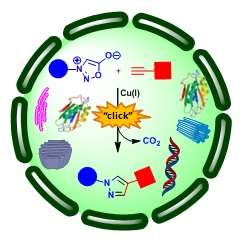New 'click' reaction: Chemistry applicable to living organisms

Two CEA-Ibitec-S teams have developed a new "click" chemistry process for specific assembly of two components without modifying their properties or the medium in which the reaction takes place. The process can be carried out under any conditions, whatever the characteristics of the medium. This new click reaction can be used to connect two components (molecules, proteins, nanoparticles, etc.) in biological media as complex as human blood. These results have been published on the Angewandte Chemie website.
Using an approach based on high-speed screening of thousands of reagent combinations, two Ibitec-S teams have discovered a new reaction meeting all the criteria of what is known as click chemistry:
- effective under any reaction conditions;
- applicable to biological media;
- selective (the reaction must not interfere with satisfactory functioning of the medium).
The reaction developed by the researchers can assemble two components specifically, without altering their properties or their medium. This is accomplished by attaching a particular chemical group to each of the components (two proteins, for example): a dipole called sydnone (heterocyclic chemical group bearing a positive and a negative charge) to one component, an alkyne group (with a triple chemical bond, see figure 1) to the other. These two groups act to "click" the two components together when the click reaction catalyst (copper) is injected into the medium.
Applications
Although chemists have thousands of chemical reactions they can use to build increasingly sophisticated molecular edifices, only a few of these reactions can be used by biologists. Biological media have characteristics (temperature, water, osmotic pressure, etc.) that make it impossible to transpose most chemical reactions to them, even reactions that are fully mastered in vitro. The requirements for a reaction applicable to biological media are particularly restrictive: aqueous medium, ambient temperature, presence of many functional groups (thiols, amines, etc.). Consequently, very few reactions can be used with biological materials.
This reaction can be used to connect two components in biological media as complex as human blood. The potential applications of this new click reaction extend from medicinal chemistry (e.g. attachment of drugs to therapeutic antibodies) to biotechnology (e.g. tracers for medical imaging).
More information: Kolodych, S., et al. (2013), Discovery of Chemoselective and Biocompatible Reactions Using a High-Throughput Immunoassay Screening, Angew. Chem. Int. Ed. DOI: 10.1002/anie.201305645
Taran, F. et al. Procédé de fabrication de pyrazoles, nouveaux pyrazoles et applications, Fr. Demande N°1351146 (11/02/2013).
Journal information: Angewandte Chemie , Angewandte Chemie International Edition
Provided by Commissariat a l'Energie Atomique


















